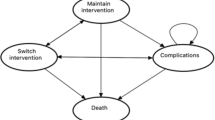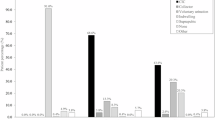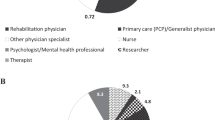Abstract
Study design
Qualitative survey.
Objectives
Examine clinicians’ perspectives on adherence to published evidence-based guidelines and clinician-perceived barriers, and facilitators to optimising inpatient bladder management within one Spinal Cord Injury (SCI) service.
Setting
Surgical Hospital (acute care) and SCI Unit (sub-acute, rehabilitation) in Western Australia (WA).
Methods
Clinicians reviewed an ‘Evidence Matrix’ summarising published clinical practice guidelines and recommendations for SCI bladder management. Focus groups examined the extent to which current practice adhered to recommendations and identified perceived barriers and facilitators to optimal management. Data were analysed thematically using a deductive approach.
Results
Current management closely mirrors published recommendations. Key facilitators included long-standing prioritisation of rapid progression from urethral indwelling (IDC) to a 6 hourly intermittent catheterisation (IC) protocol; regular competency audits of catheterisation technique; and a Spinal Urology Clinical Nurse Consultant (CNC) position. Barriers included limited resources/staffing; restricted access to Neuro-urology consultation; inter-disciplinary communication gaps; and delays in determining and implementing long-term bladder management.
Conclusions
Inpatient SCI bladder care in WA closely emulates published evidence, although adherence at other sites may reveal different practices. Bladder management was found to have been facilitated by a strong culture of practice led by Neuro-urologists, informed by evidence and embraced by Senior Clinicians. Further reduction in duration of initial IDC, provision of early and ongoing Neuro-urology consultations as part of standard care, increased interdisciplinary communication and dedicated SCI Urology theatre lists would further optimise management.
Similar content being viewed by others
Log in or create a free account to read this content
Gain free access to this article, as well as selected content from this journal and more on nature.com
or
Data availability
Data are stored on a password protected USB and on NVivo. The datasets generated and/or analysed during the current study will be made available in The University of Western Australia’s research repository; https://research-repository.uwa.edu.au/en/datasets.
References
Vigil HR, Hickling DR. Urinary tract infection in the neurogenic bladder. Transl Androl Urol. 2016;5:72–87.
Middleton J, Ramakrishnan K, Cameron I. Innovation NAfC. Management of the Neurogenic Bladder for Adults with Spinal Cord Injuries. 3rd Edition. Agency for Clinical Innovation, Chatswood NSW, 2014. p. 1–15.
Everaert K, Lumen N, Kerckhaert W, Willaert P, van Driel M. Urinary tract infections in spinal cord injury: prevention and treatment guidelines. Acta Clin Belgica. 2009;64:335–40.
Hooton TM, Bradley SF, Cardenas DD, Colgan R, Geerlings SE, Rice JC, et al. Diagnosis, Prevention, and Treatment of Catheter-Associated Urinary Tract Infection in Adults: 2009 International Clinical Practice Guidelines from the Infectious Diseases Society of America. Clin Infect Dis. 2010;50:625–63.
Ryu KH, Kim YB, Yang SO, Lee JK, Jung TY. Results of urine culture and antimicrobial sensitivity tests according to the voiding method over 10 years in patients with spinal cord injury. Korean J Urol. 2011;52:345–9.
Hennessey DB, Kinnear N, MacLellan L, Byrne CE, Gani J, Nunn AK. The effect of appropriate bladder management on urinary tract infection rate in patients with a new spinal cord injury: a prospective observational study. World J Urol. 2019;37:2183–8.
Goodes LM, King GK, Rea A, Murray K, Boan P, Watts A, et al. Early urinary tract infection after spinal cord injury: a retrospective inpatient cohort study. Spinal Cord 2019;58:25–34.
Nicolle LE. Urinary catheter-associated infections. Infect Dis Clin North Am. 2012;26:13–27.
Guttmann L, Frankel H. The value of intermittent catheterisation in the early management of traumatic paraplegia and tetraplegia. Paraplegia 1966;4:63–84.
Hill TC, Baverstock R, Carlson KV, Estey EP, Gray GJ, Hill DC, et al. Best practices for the treatment and prevention of urinary tract infection in the spinal cord injured population. Can Urol Assoc J. 2013;7:122–30.
Zermann D, Wunderlich H, Derry F, Schroder S, Schubert J. Audit of early bladder management complications after spinal cord injury in first-treating hospitals. Eur Urol. 2000;37:156–60.
Goodwin DM, Brock J, Dunlop S, Goodes L, Middleton J, Nunn A, et al. Optimal bladder management following spinal cord injury: evidence, practice and a cooperative approach driving future directions in Australia. Arch Phys Med Rehabil. 2018;99:2118–21.
Cameron AP, Wallner LP, Tate DG, Sarma AV, Rodriguez GM, Clemens JQ. Bladder management after spinal cord injury in the United States 1972 to 2005. J Urol. 2010;184:213–7.
Razdan S, Leboeuf L, Meinbach DS, Weinstein D, Gousse AE. Current practice patterns in the urologic surveillance and management of patients with spinal cord injury. Urology 2003;61:893–6.
Rikken B, Blok BF. Management of neurogenic bladder patients in The Netherlands: do urologists follow guidelines? Neurourol Urodyn. 2008;27:758–62.
Bycroft J, Hamid R, Bywater H, Patki P, Craggs M, Shah J. Variation in urological practice amongst spinal injuries units in the UK and Eire. Neurourol Urodyn. 2004;23:252–6.
Kitahara S, Iwatsubo E, Yasuda K, Ushiyama T, Nakai H, Suzuki T, et al. Practice patterns of Japanese physicians in urologic surveillance and management of spinal cord injury patients. Spinal Cord 2005;44:362–8.
Tong A, Sainsbury P, Craig J. Consolidated criteria for reporting qualitative research (COREQ): a 32-item checklist for interviews and focus groups. Int J Qual Health Care. 2007;19:349–57.
Patton MQ. Qualitative Research. In: Howell BSEDC, editor. Encyclopedia of Statistics in Behavioral Science. Chichester: John Wiley & Sons, Ltd; 2005. p. 1633-6.
Wright B, Bragge P. Spinal Cord Injury Bladder Care Recommendations Matrix. VIC, Australia: BehaviousWorks Australia, Monash University; 2015.
Bragge P, Guy S, Boulet M, Ghafoori E, Goodwin D, Wright B. A systematic review of the content and quality of clinical practice guidelines for management of the neurogenic bladder following spinal cord injury. Spinal Cord 2019;57:540–9.
Royal Institute of International Affairs. Chatham House Rule. Chatham House website [updated 2002]. https://www.chathamhouse.org/about/chatham-house-rule.
Boyatzis RE. Transforming qualitative information: thematic analysis and code development. CA: Sage Publishing, Thousand Oaks; 1998.
Edhlund B, McDougall A. Nvivo 11 Essentials. First Edition. Stallarholmen, Sweden: Lulu. com; 2016.
Escalarin De Ruz A, Garcia Leoni E, Herruzo Cabrera R. Epidemiology and risk factors for urinary tract infection in patients with spinal cord injury. J Urol. 2000;164:1285–9.
Pearman JW. Urological follow-up of 99 spinal injured patients initially managed by intermittent catherisation. Br J Urol. 1976;48:297–310.
Noll F, Russe O, Kling E, Botel U, Schreiter F. Intermittent catheterisation versus percutaneous suprapubic cystostomy in the early management of traumatic spinal cord lesions. Paraplegia 1988;26:4–9.
Stohrer M, Blok B, Castro-Diaz D, Chartier-Kastler E, Del Popolo G, Kramer G, et al. EAU guidelines on neurogenic lower urinary tract dysfunction. Eur Urol. 2009;56:81–8.
Krebs J, Wollner J, Pannek J. Risk factors for symptomatic urinary tract infections in individuals with chronic neurogenic lower urinary tract dysfunction. Spinal Cord 2016;54:682–6.
Brolliar SM, Moore M, Thompson HJ, Whiteside LK, Mink RB, Wainwright MS, et al. A Qualitative Study Exploring Factors Associated with Provider Adherence to Severe Pediatric Traumatic Brain Injury Guidelines. J Neurotrauma. 2016;33:1554–60.
Lanig IS, New PW, Burns AS, Bilsky G, Benito-Penalva J, Bensmail D, et al. Optimizing the management of spasticity in people with spinal cord damage: a clinical care pathway for assessment and treatment decision making from the ability network, an international initiative. Arch Phys Med Rehabilit. 2018;99:1681–7.
Cardenas DD, Moore KN, Dannels-McClure A, Scelza WM, Graves DE, Brooks M, et al. Intermittent catheterization with a hydrophilic-coated catheter delays urinary tract infections in acute spinal cord injury: a prospective, randomized, multicenter trial. PM R 2011;3:408–17.
De Ridder DJ, Everaert K, Fernandez LG, Valero JV, Duran AB, Abrisqueta ML, et al. Intermittent catheterisation with hydrophilic-coated catheters (SpeediCath) reduces the risk of clinical urinary tract infection in spinal cord injured patients: a prospective randomised parallel comparative trial. Eur Urol. 2005;48:991–5.
Li L, Ye W, Ruan H, Yang B, Zhang S, Li L. Impact of hydrophilic catheters on urinary tract infections in people with spinal cord injury: systematic review and meta-analysis of randomized controlled trials. Arch Phys Med Rehabilit. 2013;94:782–7.
Bermingham SL, Hodgkinson S, Wright S, Hayter E, Spinks J, Pellowe C. Intermittent self catheterisation with hydrophilic, gel reservoir, and non-coated catheters: a systematic review and cost effectiveness analysis. BMJ 2013;346:e8639.
Shamout S, Biardeau X, Corcos J, Campeau L. Outcome comparison of different approaches to self-intermittent catheterization in neurogenic patients: a systematic review. Spinal Cord 2017;55:629–43.
Acknowledgements
We thank Ms S. Jonescu, Trauma Case Manager, Royal Perth Hospital, and Ms Anne Watts, Nurse Unit Manager, Fiona Stanley Hospital, for distributing study packs to relevant staff positions. Thank you also to Ms S. Knape, Registered Nurse, for professional and effective independent facilitation of study focus groups.
Funding
Project Grant (number: N/A), Neurotrauma Research Program, Perron Institute for Neurological and Translational Science, Western Australia. The University of Western Australia (in-kind funding via staff salary support).
Author information
Authors and Affiliations
Contributions
LG & SD: Grant writing, study design, project oversight, data collection and analyses, paper, table preparation. GK: Data collection and analyses, intellectual input on paper. GK, DG, PB, AW, JB, JM: Intellectual input on study design and focus group questions; review, editing and approval of paper.
Corresponding author
Ethics declarations
Conflict of interest
The authors declare that they have no conflict of interest.
Ethical approval
All applicable Institutional and governmental regulations concerning the ethical use of data from consenting hospital staff participants were followed. The South Metropolitan Health Service Human Research Ethics Committee provided ethical approval (16-148).
Informed consent
All participants (Clinicians) were provided with a Participant Information and Consent Form requiring their signatures.
Additional information
Publisher’s note Springer Nature remains neutral with regard to jurisdictional claims in published maps and institutional affiliations.
Supplementary information
Rights and permissions
About this article
Cite this article
Goodes, L.M., King, G.K., Goodwin, D.M. et al. Barriers and facilitators to optimising inpatient bladder management after spinal cord injury. Spinal Cord 58, 1291–1300 (2020). https://doi.org/10.1038/s41393-020-0487-6
Received:
Revised:
Accepted:
Published:
Issue date:
DOI: https://doi.org/10.1038/s41393-020-0487-6



